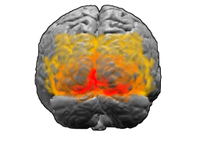
Photo from wikipedia
Grasping is the most important skilled motor act of primates. It is based on a series of sensorimotor transformations through which the affordances of the objects to be grasped are… Click to show full abstract
Grasping is the most important skilled motor act of primates. It is based on a series of sensorimotor transformations through which the affordances of the objects to be grasped are transformed into appropriate hand movements. It is generally accepted that a circuit formed by inferior parietal areas AIP and PFG and ventral premotor area F5 represents the core circuit for sensorimotor transformations for grasping. However, selection and control of appropriate grip should also depend on higher-order information, such as the meaning of the object to be grasped, and the overarching goal of the action in which grasping is embedded. In this review, we describe recent findings showing that specific sectors of the ventrolateral prefrontal cortex are instrumental in controlling higher-order aspects of grasping. We show that these prefrontal sectors control the premotor cortex through two main gateways: the anterior subdivision of ventral area F5-sub-area F5a-, and the pre-supplementary area (area F6). We then review functional studies showing that both F5a and F6, besides being relay stations of prefrontal information, also play specific roles in grasping. Namely, sub-area F5a is involved in stereoscopic analysis of 3D objects, and in planning cue-dependent grasping activity. As for area F6, this area appears to play a crucial role in determining when to execute the motor program encoded in the parieto-premotor circuit. The recent discovery that area F6 contains a set of neurons encoding specific grip types suggests that this area, besides controlling “when to go”, also may control the grip type, i.e., “how to go”. We conclude by discussing clinical syndromes affecting grasping actions and their possible mechanisms.
Journal Title: Experimental Brain Research
Year Published: 2017
Link to full text (if available)
Share on Social Media: Sign Up to like & get
recommendations!